Mechanical Pressure Characterization of CNT-Graphene Composite Material
Abstract
1. Introduction
2. Materials, Sample Fabrication and Experimental Setup
2.1. Materials
2.2. Samples Fabrication
2.3. Setup and Measurements
3. Results and Discussion
3.1. Scanning Electron Microscopy
3.2. Pressure vs. Resistance
3.3. Experimental vs. SIMULATION
4. Conclusions
Author Contributions
Funding
Acknowledgments
Conflicts of Interest
References
- Li, C.; Thostenson, E.T.; Chou, T.-W. Sensors and actuators based on carbon nanotubes and their composites: A review. Compos. Sci. Technol. 2008, 68, 1227–1249. [Google Scholar] [CrossRef]
- Jiang, N.; Namilae, S.; Unnikrishnan, V.U. Silicone/Carbon Nanotube Sheet Biofidelic Piezoresistive Sandwich Composites. J. Eng. Mater. Technol. 2019, 142, 1–29. [Google Scholar] [CrossRef]
- Euler, K.-J. The conductivity of compressed powders. A review. J. Power Sources 1978, 3, 117–136. [Google Scholar] [CrossRef]
- Li, J.; Li, W.; Huang, W.; Zhang, G.; Sun, R.; Wong, C.-P. Fabrication of highly reinforced and compressible graphene/carbon nanotube hybrid foams via a facile self-assembly process for application as strain sensors and beyond. J. Mater. Chem. C 2017, 5, 2723–2730. [Google Scholar] [CrossRef]
- Nair, R.R.; Blake, P.; Grigorenko, A.N.; Novoselov, K.S.; Booth, T.J.; Stauber, T.; Peres, N.M.; Geim, A.K. Fine structure constant de_nes visual transparency of grapheme. Science 2008, 320, 1308. [Google Scholar] [CrossRef] [PubMed]
- Yu, J.; Liu, G.; Sumant, A.V.; Goyal, V.; Balandin, A.A. Graphene-on-Diamond Devices with Increased Current-Carrying Capacity: Carbon sp2-on-sp3 Technology. Nano Lett. 2012, 12, 1603–1608. [Google Scholar] [CrossRef]
- Javey, A.; Qi, P.; Wang, Q.; Dai, H. Ten-to 50-nm-long quasiballistic carbon nanotube devices obtained without complex lithogra-phy. Proc. Natl. Acad. Sci. USA 2004, 101, 13408–13410. [Google Scholar] [CrossRef]
- Wang, L.; Yang, Z.; Cui, Y.; Wei, B.; Xu, S.; Sheng, J.; Wang, M.; Zhu, Y.; Fei, W. Graphene-copper composite with micro-layered grains and ultrahigh strength. Sci. Rep. 2017, 7, 41896. [Google Scholar] [CrossRef]
- Boonbumrung, A.; Sae-Oui, P.; Sirisinha, C. Reinforcement of Multiwalled Carbon Nanotube in Nitrile Rubber: In Comparison with Carbon Black, Conductive Carbon Black, and Precipitated Silica. J. Nanomater. 2016, 2016, 6391572. [Google Scholar] [CrossRef]
- Zhu, Y.; Cai, H.; Ding, H.; Pan, N.; Wang, X. Fabrication of Low-Cost and Highly Sensitive Graphene-Based Pressure Sensors by Direct Laser Scribing Polydimethylsiloxane. ACS Appl. Mater. Interfaces 2019, 11, 6195–6200. [Google Scholar] [CrossRef]
- Shin, S.-H.; Ji, S.; Choi, S.; Pyo, K.-H.; An, B.W.; Park, J.; Kim, J.; Kim, J.-Y.; Lee, K.-S.; Kwon, S.-Y.; et al. Integrated arrays of air-dielectric graphene transistors as transparent active-matrix pressure sensors for wide pressure ranges. Nat. Commun. 2017, 8, 14950. [Google Scholar] [CrossRef] [PubMed]
- Wen, L.; Li, F.; Cheng, H.-M. Carbon Nanotubes and Graphene for Flexible Electrochemical Energy Storage: From Materials to Devices. Adv. Mater. 2016, 28, 4306–4337. [Google Scholar] [CrossRef] [PubMed]
- Karimov, K.S.; Sulaiman, K.; Ahmad, Z.; Akhmedov, K.M.; Mateen, A. Novel pressure and displacement sensors based on carbon nanotubes. Chin. Phys. B 2015, 24, 018801. [Google Scholar] [CrossRef]
- Tian, H.; Shu, Y.; Wang, X.-F.; Mohammad, M.A.; Bie, Z.; Xie, Q.-Y.; Li, C.; Mi, W.-T.; Yang, Y.; Ren, T.-L. A Graphene-Based Resistive Pressure Sensor with Record-High Sensitivity in a Wide Pressure Range. Sci. Rep. 2015, 5, srep08603. [Google Scholar] [CrossRef]
- Doshi, S.M.; Thostenson, E.T. Thin and Flexible Carbon Nanotube-Based Pressure Sensors with Ultrawide Sensing Range. ACS Sens. 2018, 3, 1276–1282. [Google Scholar] [CrossRef]
- Hasan, S.A.U.; Jung, Y.; Kim, S.; Jung, C.-L.; Oh, S.; Kim, J.; Lim, H. A Sensitivity Enhanced MWCNT/PDMS Tactile Sensor Using Micropillars and Low Energy Ar+ Ion Beam Treatment. Sensors 2016, 16, 93. [Google Scholar] [CrossRef]
- Chen, S.; Luo, J.; Wang, X.; Li, Q.; Zhou, L.; Liu, C.; Feng, C. Fabrication and Piezoresistive/Piezoelectric Sensing Characteristics of Carbon Nanotube/PVA/Nano-ZnO Flexible Composite. Sci. Rep. 2020, 10, 8895. [Google Scholar] [CrossRef]
- Rani, A.A.; Nam, S.-W.; Oh, K.-A.; Park, M. Electrical Conductivity of Chemically Reduced Graphene Powders under Compression. Carbon Lett. 2010, 11, 90–95. [Google Scholar] [CrossRef]
- Marinho, B.; Ghislandi, M.M.; Tkalya, E.E.; Koning, C.E.; De With, G. Electrical conductivity of compacts of graphene, multi-wall carbon nanotubes, carbon black, and graphite powder. Powder Technol. 2012, 221, 351–358. [Google Scholar] [CrossRef]
- Wang, C.; Hou, X.; Cui, M.; Yu, J.; Fan, X.; Qian, J.; He, J.; Geng, W.; Mu, J.; Chou, X. An ultra-sensitive and wide measuring range pressure sensor with paper-based CNT film/interdigitated structure. Sci. China Mater. 2020, 63, 403–412. [Google Scholar] [CrossRef]
- Huang, H.; Su, S.; Wu, N.; Wan, H.; Wan, S.; Bi, H.; Sun, L. Graphene-Based Sensors for Human Health Monitoring. Front. Chem. 2019, 7, 399. [Google Scholar] [CrossRef] [PubMed]
- Sánchez-González, J.; Macías-García, A.; Alexandre-Franco, M.; Gómez-Serrano, V. Electrical conductivity of carbon blacks under compression. Carbon 2005, 43, 741–747. [Google Scholar] [CrossRef]
- Karimov, K.S.; Chani, M.T.S.; Khalid, F.A.; Khan, A.; Khan, R. Carbon nanotube—Cuprous oxide composite based pressure sensors. Chin. Phys. B 2012, 21, 16102. [Google Scholar] [CrossRef]
- Karimov, K.S.; Khalid, F.A.; Chani, M.T.S. Carbon nanotubes based strain sensors. Measurement 2012, 45, 918–921. [Google Scholar] [CrossRef]
- Fierro, V.; Marêché, J.; Payot, F.; Furdin, G. Electrical conductivity of carbonaceous powders. Carbon 2002, 40, 2801–2815. [Google Scholar] [CrossRef]
- Sahini, M. Applications of Percolation Theory; Taylor & Francis: London, UK, 1994; ISBN 0748400761/9780748400768. [Google Scholar]
- Fraden, J. Handbook of Modern Sensors: Physics, Designs, and Applications, 4th ed.; Springer Science & Business Media: New York, NY, USA, 2010. [Google Scholar]
- Kumar, N. Comprehensive Physics; Luxmi Publications (P) LTD: New Delhi, India, 2005. [Google Scholar]
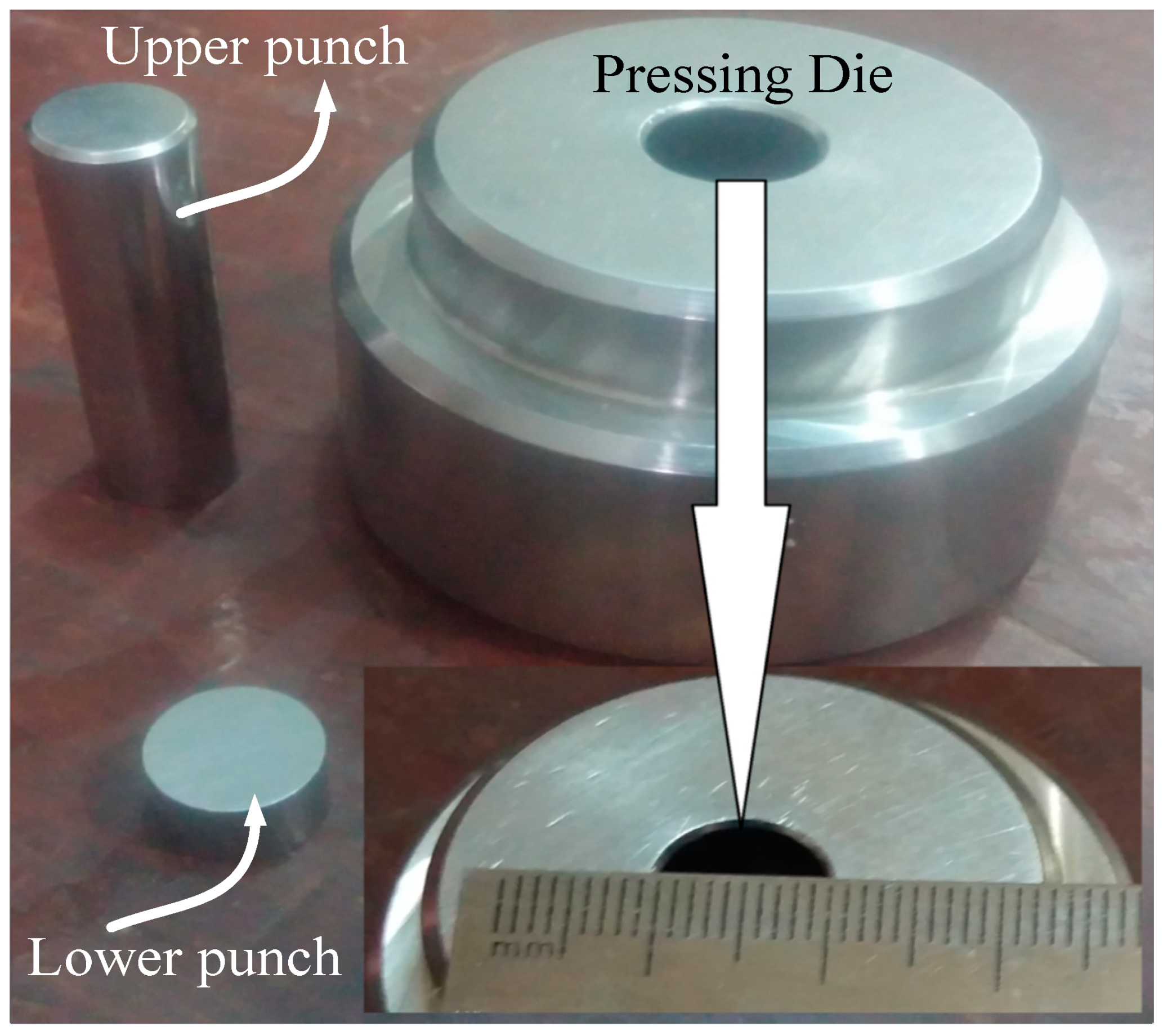
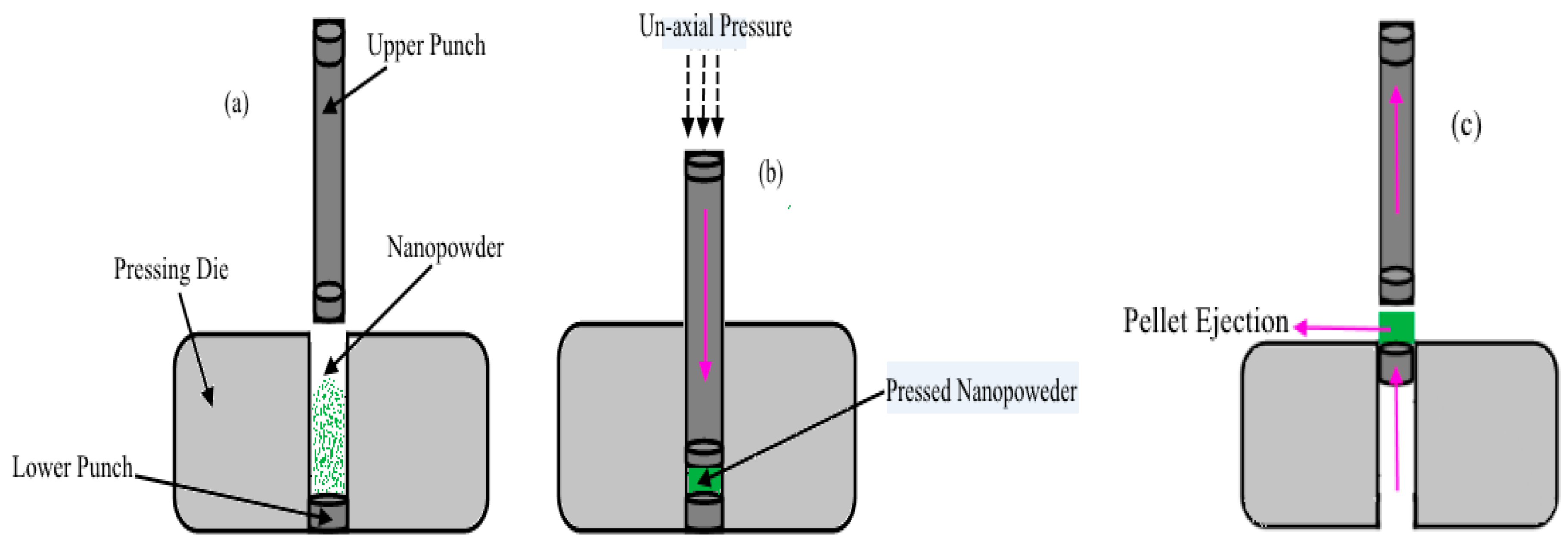
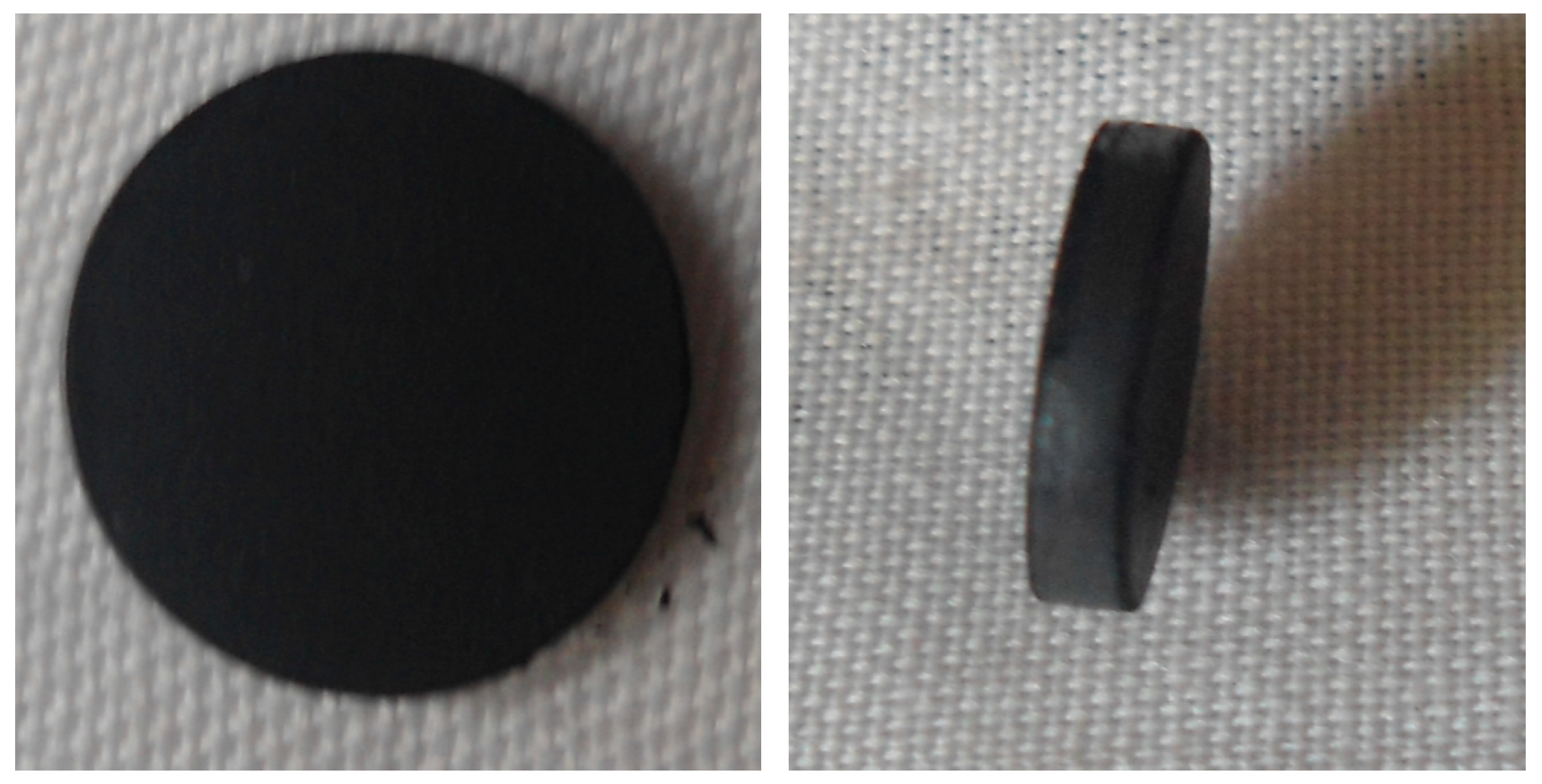

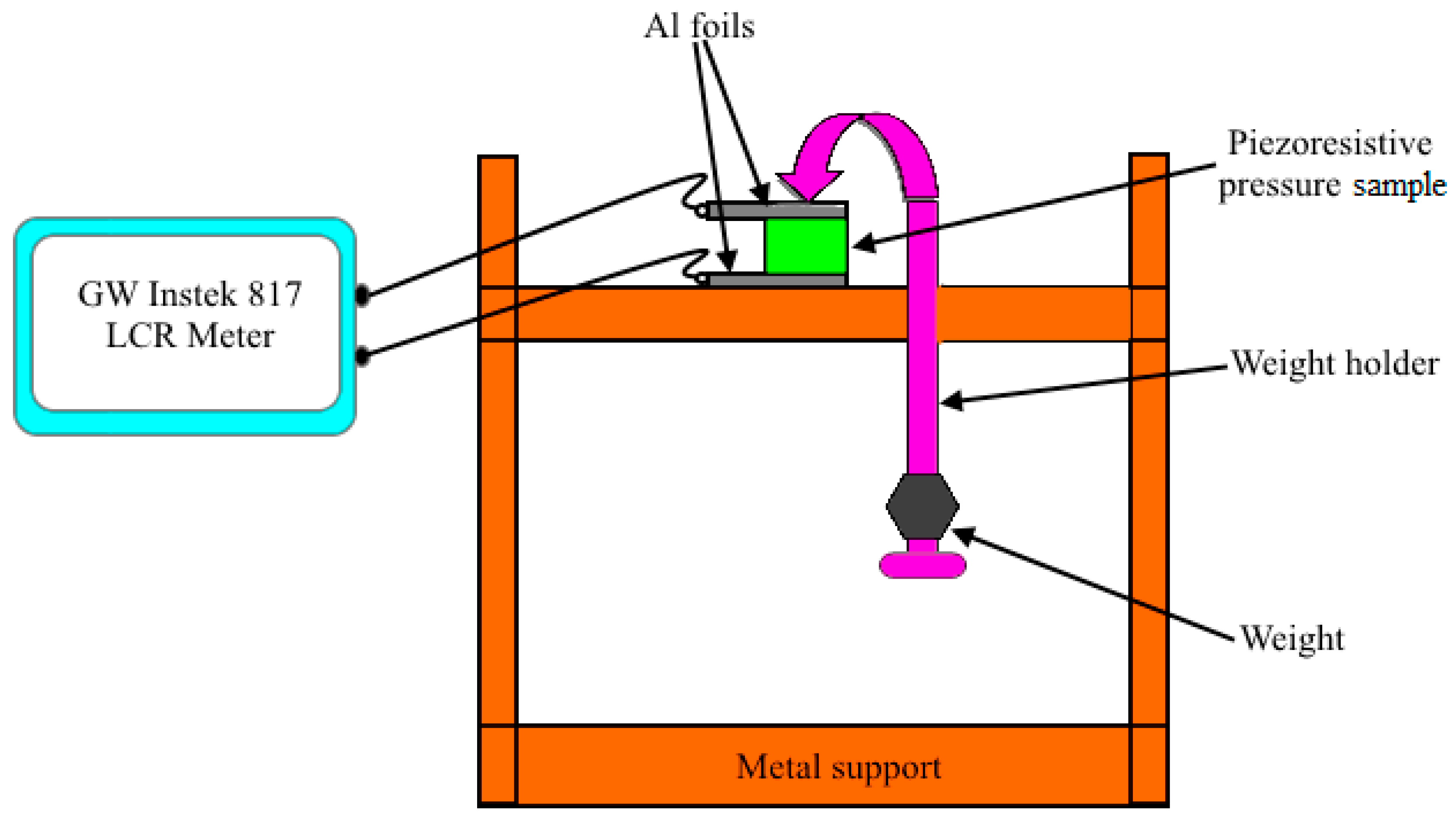

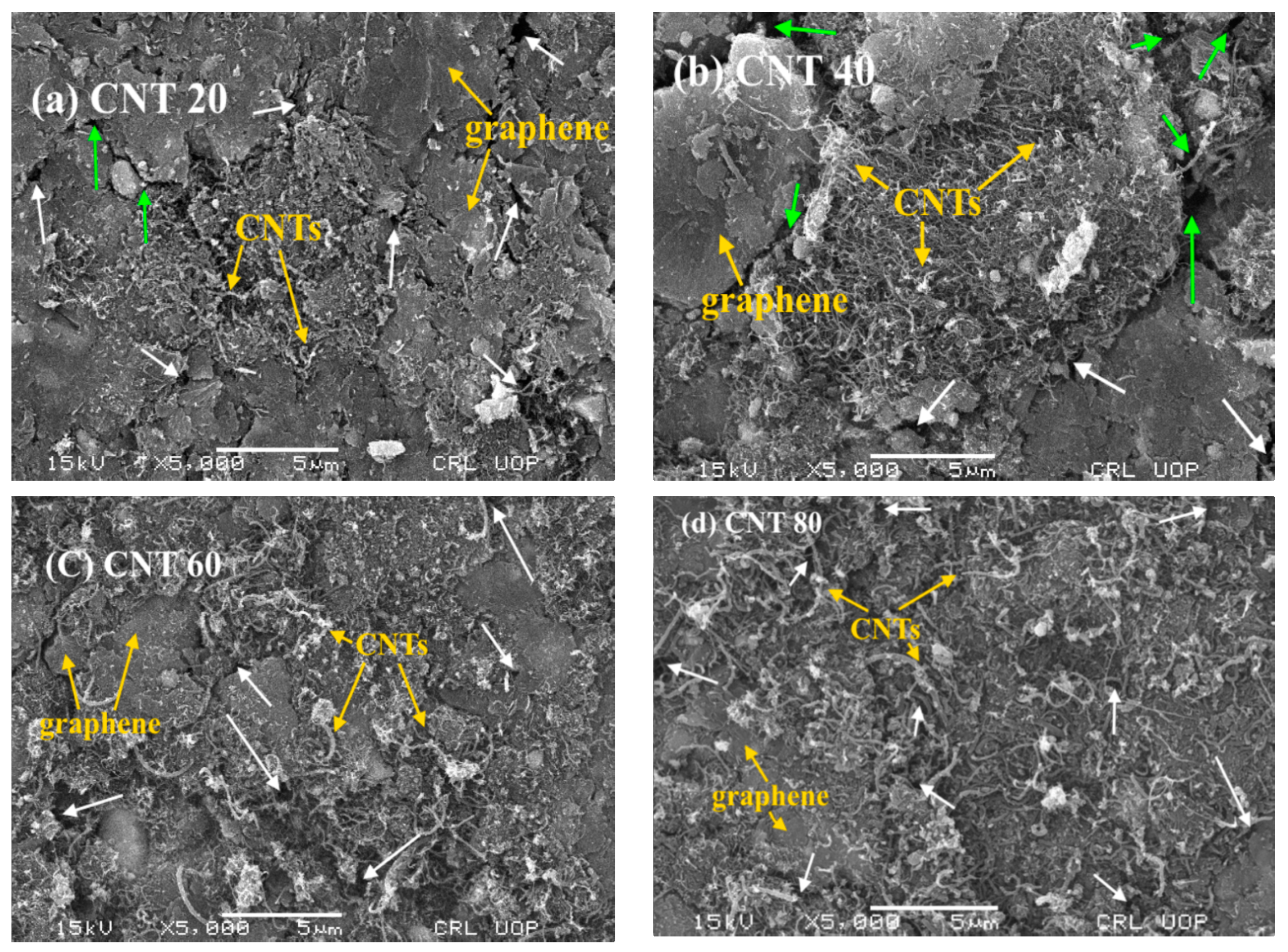

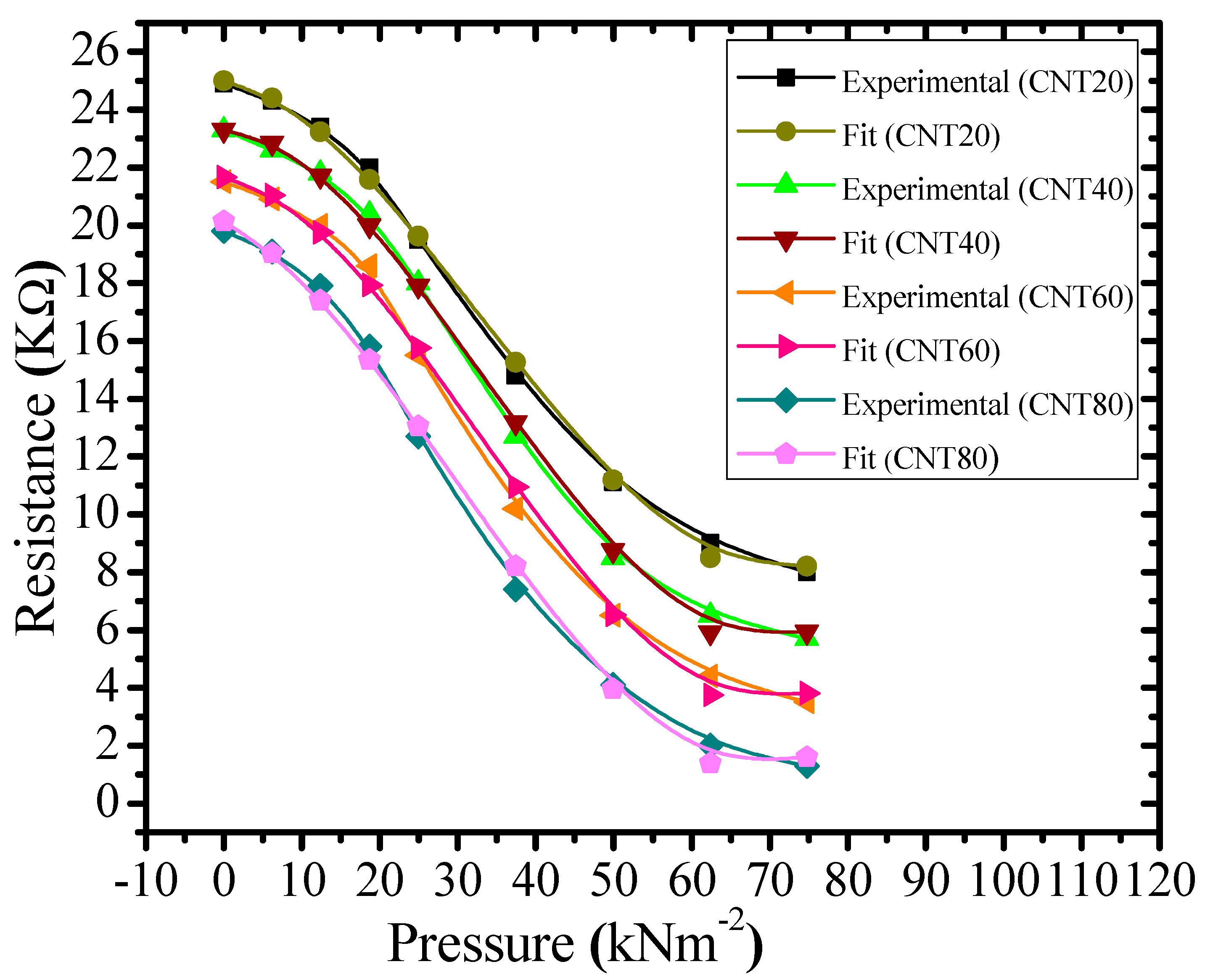
| Test Frequency | Basic Accuracy | Test Speed | Test Signal Levels | Measurement Range | Quality 75 Factor | Dissipation Factor |
|---|---|---|---|---|---|---|
| 12 Hz–10 kHz | 0.05% | 68 ms | 5 mV–1.275 Vrms | 0.00001 Ω–99,999 kΩ | 0.0001–9999 | 0.0001–9999 |
| Composite | CO (kN−2m2) | C1 (kN−2m2) | C2 (kN−2m2) | C3 (kN−2m2) |
|---|---|---|---|---|
| CNT20 | 25 | −0.043 | −0.009 | 9.07 × 10−5 |
| CNT40 | 23.3 | −0.006 | −0.012 | 1.08 × 10−4 |
| CNT60 | 21.6 | −0.041 | −0.011 | 1.05 × 10−4 |
| CNT80 | 20.2 | −0.129 | −0.008 | 9.34 × 10−5 |
Publisher’s Note: MDPI stays neutral with regard to jurisdictional claims in published maps and institutional affiliations. |
© 2020 by the authors. Licensee MDPI, Basel, Switzerland. This article is an open access article distributed under the terms and conditions of the Creative Commons Attribution (CC BY) license (http://creativecommons.org/licenses/by/4.0/).
Share and Cite
Ali, A.; Ali, F.; Irfan, M.; Muhammad, F.; Glowacz, A.; Antonino-Daviu, J.A.; Caesarendra, W.; Qamar, S. Mechanical Pressure Characterization of CNT-Graphene Composite Material. Micromachines 2020, 11, 1000. https://doi.org/10.3390/mi11111000
Ali A, Ali F, Irfan M, Muhammad F, Glowacz A, Antonino-Daviu JA, Caesarendra W, Qamar S. Mechanical Pressure Characterization of CNT-Graphene Composite Material. Micromachines. 2020; 11(11):1000. https://doi.org/10.3390/mi11111000
Chicago/Turabian StyleAli, Asar, Farman Ali, Muhammad Irfan, Fazal Muhammad, Adam Glowacz, Jose Alfonso Antonino-Daviu, Wahyu Caesarendra, and Salman Qamar. 2020. "Mechanical Pressure Characterization of CNT-Graphene Composite Material" Micromachines 11, no. 11: 1000. https://doi.org/10.3390/mi11111000
APA StyleAli, A., Ali, F., Irfan, M., Muhammad, F., Glowacz, A., Antonino-Daviu, J. A., Caesarendra, W., & Qamar, S. (2020). Mechanical Pressure Characterization of CNT-Graphene Composite Material. Micromachines, 11(11), 1000. https://doi.org/10.3390/mi11111000






